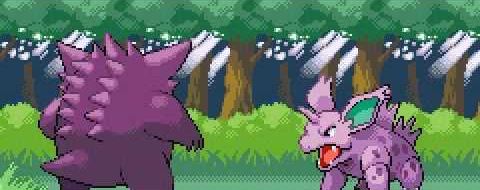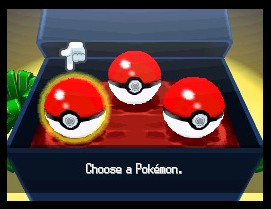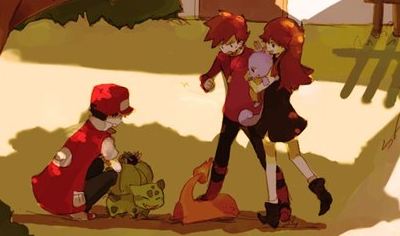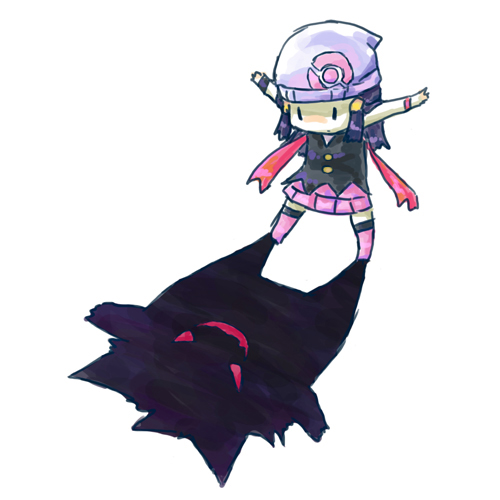Pokemon Battle Box pt.4
 Saturday, May 28, 2011 at 9:46AM
Saturday, May 28, 2011 at 9:46AM I have a history of not being impressed by RPGs. Before I started this blog, I spent 3 weeks straight coding an improved action RPG engine in a project called Neo*RPG. In the early days, I expressed my disdain for static, repetitive RPG strategies that revolve around the actions of attack-attack-heal. This was long before I articulated the importance of understanding design spaces and clean design. Since I started Critical-Gaming there hasn't been a new generation of Pokemon RPGs. All these years I thought I knew what the Pokemon battle system had to offer. Now, after putting in 130 hours into Pokemon Black and doing plenty of research into the competitive battling scene, I can state with confidence that Pokemon has one of, if not the, best turn based RPG battle systems. The remainder of this article will explore this claim in great detail.

The first Pokemon battle in both the Anime and the GameBoy game.
The first issue I have to clear up is the difference between battling and competitive battling. The difference between the battling you do playing through the single player campaign and competitive battling is vast. The single player game is designed with variable difficulty that the player can adjust. The ability to use items and switch out your Pokemon after KOing an opponent's Pokemon weakens the battle system. After all, using items is where the heal part of dreaded attack-attack-heal tactic comes from.
In a competitive battle, you do not have access to such options. From the start of the match, you're limited to the attacks and abilities of your 6 Pokemon. After you KO an opposing Pokemon, the opponent will bring in another forcing you to deal with the matchup. You can find competitive type battles in the Battle Subway or by playing against real players online. In fact, being a long running, popular competitive video game gives the Pokemon battle system an automatic edge over other RPG systems. The scrutiny of competition is the best stress test for the integrity of a gameplay system. If players greedy for victory cannot break the system or bend it very far, it has sufficient integrity. The most the Smogon competitive rules have done to competitive is ban a few hold items, a few strategies/moves, and arrange the Pokemon into tiers to keep matchups fair.
Before continuing, I should say that when I refer to Pokemon's battle system I mean the 6v6 singles battle system. I have little experience with double, triple, and rotation battles. And from what I can tell there isn't much of a competitive scene for these types either.
I believe the best way to explain what makes the Pokemon battle system so good is a thorough break down of its design all the way down to the mecahnics. It's going to get a bit technical, so do visit the links provided for further explanation of the terms and concepts used.
Mechanics
All of the battle actions play out in simultaneous turn-based fashion. Whether you and your opponent switch Pokemon or attack everything plays out one action at a time according to their speed or priority. Switching Pokemon happens first, then items are launched, and finally attacks. The Pokemon that attacks first is the one with the higher speed stat. Depending on the attack or ability of a Pokemon, certain actions take priority over speedy Pokemon almost like interrupts. But overall, turn-based time is simple allowing even beginning players to plan out their strategies by counting turns.
Without real-time gameplay, the skill spectrum only reflects knowledge skills almost entirely. Nobody thinks Pokemon is hard to control. Just tap the screen and you can execute as well as any pro. However, being competitive requires a lot of game knowledge, metagame knowledge, and the ability to keep track of numerous factors in battle.
Pokemon is played by issuing commands. These types of mechanics can be very abstract. When Pokemon battle they're not facing off against each other in an arena rendered in dynamic space. When my Ferrothorn uses POWER WHIP there is no hitbox that lauches out from my Pokemon toward the opponent. Everything in the game is a significant abstraction of the actions they represent. While I considered such a level of abstraction as a negative thing years ago, I have since softened my view. Now, I know great abstractions like in the Pokemon battle system work to support the higher level, emergent gameplay while resting on a foundation of solid, simple interactions.

Variation
As I've stated before, Pokemon B/W features 649 Pokemon, around 455 different attacks, 162 unique abilities, and 150 hold items. But none of these stats tell us if there are redundant, useless, or unused elements. For example, if Surf was the most powerful attack in the game by far and all Pokemon could learn it, then a lot of the variation would be hampered. Surf would be the dominant attacking strategy. Whether you play competitively or not, it would make little sense to not use Surf in many cases.
Figuring out the minimum degree of difference, the smallest amount of difference to make an element unique, is a necessary step when discussing variation. The vast majority of attacks in Pokemon that do damage are designed around a base of 5 points. So an attack that does 100 base damage instead of 95 is just enough to be functionally distinct. We should also consider design space, the overall range of variation possible for gameplay elements. Each Pokemon attack features so many other variables: PP (ammo), accuracy, base damage, elemental type (1 of 17), physical/special/none attribute, priority (speed), and additional effects from status afflictions, weather changes, etc. There is certainly more than enough variables in Pokemon B/W to make all the gameplay elements unique.
This is not to say that every attack is useful in competition. There are many attacks that are functionally inferior in just about every way to stronger versions. These weak attacks are mainly in the game to support the fiction of growing Pokemon. For example, TACKLE and SCRATCH are not very strong attacks because these are the attacks that low level, "baby" Pokemon know. As Pokemon evolve and level up, they learn more powerful versions of these attacks like STRENGTH, BODY SLAM, or SLASH.
There's another reason why having inferior attacks is important. As a simplified example, certainly you'd use an attack like Surf with a 95 base attack strength over Scald with 80 if damage is the only factor that's important. But not all Pokemon get access to both attacks. Many water Pokemon can learn both, but Pokemon like Emboar (fire/fighting) can only learn Scald. Having a water type move on a fire pokemon is unique. Though it's weaker than Surf, having it in the game allows for water Pokemon to use the strongest water attacks and other Pokemon types to use the weaker water moves.

How could you lose Charmander?! You had the favorable matchup!
If you know who created this image, let me know.
Depth and Interesting Choices
This is the most important part of my battle analysis. Many RPGs have similar, command based mechanics. Many RPGs have lot of complexities to create lots of variety. But depth, balance, and interesting choices are emergent qualities, which make them harder to design and less likely for a game to have. Pokemon has it all.
Some fault Pokemon battles for essentially being a series of Rock Paper Scissors (RPS) like interactions. This is like claiming that the unit matchups in Advance Wars are a Rock Paper Scissors. Without a doubt the weakness and resistances interplay between Pokemon attacks and types is the core of the battle system. However, the shear combinations and matchups are far beyond the simplicity of RPS. Every Pokemon RPG adventure starts off giving players a choice of 3 Pokemon types; fire, water, grass. This is because these types are a perfect RPS style interplay loop. From these simple beginnings players learn the matchups between all 17 types. Factor in that Pokemon can be two types, and the possible matchup combinations explode in an uneven and interesting way. In fact, Dark and Steel types were added to the series in the 2nd generation to help balance out the matups. Playing to the types is only the beginning.
In part 4 of my article series Interesting Choices: Interesting Gameplay I explained that Pokemon's battle system has enough variables for interesting choices to emerge:
Pokemon Black and White uses 6 stats, 1 ability, 1 held item, gender, and 4 moves per Pokemon. Each Pokemon can be inflicted with any number of 8 stat alterations, and just 1 of 8 status effects. With 6 Pokemon per team, field conditions, weather conditions, and 17 types with different weaknesses and resistances to each other there's more than enough properties for the game to create dynamic and variable mechanics. With so many moves that stress different parts of the design space in different ways, the design is ripe for interesting choices to emerge.
Perhaps the most clear example of interesting choices in Pokemon is the limitation of having 6 Pokemon per team, 4 attacks per Pokemon, and one held item per Pokemon. This means at most you can only cover 12/17 types, 24/455 attacks, and so on. There's simply no way to eliminate all of your weaknesses. To compensate, you need more complex strategies. Playing to the weakness and resistances of Pokemon types is a basic way to gain an advantage when battling. But as the battle goes on, you're bound to lose team members. This is why it's important to understand how to gain advantages using strategies that don't rely on pure offensive power.
A clear way to gain an advantage in any turn based game is to do more with your turn than your opponent. Likewise, if you play or pressure the opponent into wasting a turn, that's just as effective. The most basic way to win a turn is by switching in a Pokemon that will win the type matchup. In this scenario most opponents will be pressured to switch out to another Pokemon. If this happens you gain a turn of advantage.
By buffing your stats, you can essentially gain turns. For example, if you use SWORDS DANCE to sharply increase your attack strength, you technically increase your physical attacks by 2 times. So, from this point every attack is like getting two turns of damage in at once. It's the same for buffing many of your stats or nerfing your opponent's stats.
Or you can inflict status effects against opponents to nullify some of their advantages, especially the ones they spend turns to gain. For example, paralysis cuts the speed of the afflicted Pokemon. So, if you're fighting a particularly speedy foe, you might want to invest in the move THUNDER WAVE to slow it down and perhaps save a turn due to the occasional full paralysis. Of course, figuring out which Pokemon to teach THUNDER WAVE is a different matter altogether. There are many ways to gain/lose advantages and directly/indirectly battle.
As far as interesting choices design goes, Pokemon's battle system uses double blind encounters, imperfect information, and significant elements of randomness at its core. These features allow a range of different moves, Pokemon, and strategies to be used in competition and thus maintain a balance.
The double blind rounds force players into a guessing game with each decision. Educated guesses go a long way. If you guess correctly, it's obvious. The results play out right in front of you. Often times the option for making bold guesses (higher risk and reward) is always there. Will you anticipate a Pokemon switch to a specific type? Will you assume the opponent will stay in? Will you play it safe or over-predict?
Because the exact move set, abilities, held items, and custom stats of the opposing Pokemon are unknown to you throughout much of a battle, there is a lot of imperfect information. In some ways, this design rewards players for having a deep knowledge of the game/metagame because they can anticipate the unknown factors. In other ways, it opens up the gameplay for deception, scouting, mind games, and calling bluffs. These strategies are common in Poker and in Pokemon. I've watched many match videos where players choose not to reveal certain Pokemon, attacks, or abilities of their team until it could really turn the tide of the battle. While there is a lot players don't know, the longer the match goes, the more information is revealed and the more Pokemon are knocked out. So, there will naturally be less unknowns to consider.
As much as some players want completely predictable outcomes, many attacks in Pokemon have chance effects. Using an attack with anything less than 100% accuracy can result in a miss. Furthermore, many attacks have a percentage chance of inflicting a secondary effect. Whether your stats increase, the opponent's stats decrease, status is inflicted, or critical hits land, all players have to adapt to unforeseeable events.

If you know who created this image, let me know.
Simplification
To best understand the Pokemon Battle system, you must see how incredibly complex and varied the possibilities are and how players simplify it all. First, the battle system uses lifebars. To make a strategy, a specific plan of action, it's important to be able to plan moves into the future. Players mainly do this by counting turns. How many turns can I stay out before dying from poison? How many turns will I get while the opponent is asleep? How many turns will it take to KO a Pokemon from my attacks? 1-hit-KOs are great but uncommon. Anything beyond a 2-hit-KOs are fairly easy to determine based on how far the lifebar moves. Simply being able to gauge strength through lifebar movements is incredibly important. Forget trying to crunch the damage formula in real time in your head.
The lifebar design fits well with the simple stat boosting design. When your stats increase by a stage, you basically get a 1.5x increase. Boost your stats again and it's a 2x increase. The pattern continues up to 4x strong. These simple increments help players plan out exactly how much damage they'll do not based on numbers, but turns it'll take to get a KO.
Put it all together and the Pokemon battle system has many of the qualities I love. It has simple mechanics and lots of depth. Yet, the vast, almost overwhelming amount of complexity of moves, stats, and combinations of Pokemon are simplified by the double blind, imperfect information, turn-based, and lifebar design. This is not to mention that the lifebars create spectator sport moments. Check out the PokeMoshPit youtube channel for entertaining videos of Pokemon wifi battles with commentary. The commentary goes a long way in helping me understand the strategies behind the actions.
In part 5 I'll discuss how to best enjoy Pokemon B/W after you've accepted battling as the main focus of the game. Topics include difficulty, managing all the complexities, and how Pokemon B/W handles some of the negative aspects common to RPGs.


Reader Comments (4)
So looks like B&W did re-kindle your interest in battles. Had a feeling it would.
One minor correction ,Double battles do have a decent bit of players as that is what is used in official tournaments. It's just that Smogen has been around longer then doubles, and only recently gained the ability to do double battles, so naturally it focuses far more on talking about it's standard match up is.
Also the official version of doubles only allows four Pokemon on your team so that changes things up even more.
@NathanS
Thanks for the info. I heard that the main reason people play double battles is that official tournament that comes around. I also heard that its metagame used to be dominated by a few Pokes/strategies. But I didn't look into it much.
I always wanted to get into Pokemon battling since I was 12. I never had a good shot until now. When I played Diamond/Pearl youtube was barely around. So I never got hooked up into what's cool about competitive battling.
Just a comment, double battles are also highly competitive, largely due to the the pokemon Video Game Championships (VGC) that run in the summers. THese are 4 vs. 4 double battles, and before I tried double battles, my opinion of them wasn't particularly high. But now, wow, I have a complete new respect for the metagame, and I'd even go so far as to say it's even more competitive than single battles. The moves you make carry far greater weight than in singles.
@ FearZeCrawdaunt
Good comment.
Great name.
I'll keep both in mind for the future.